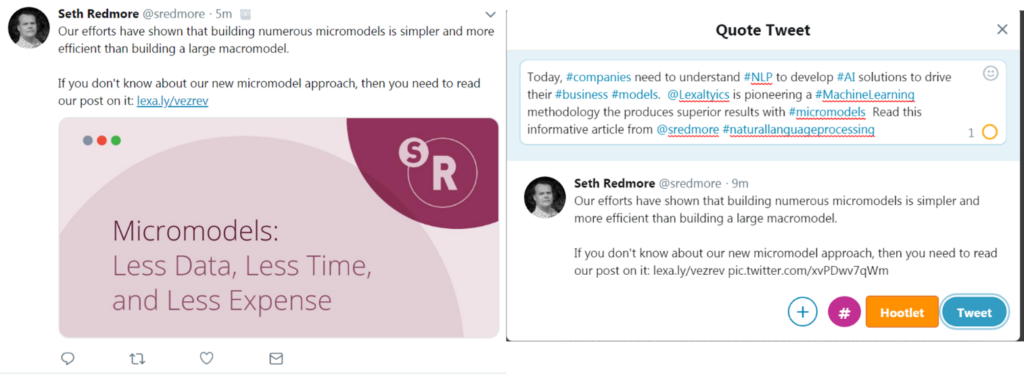Every time you Tweet, re-tweet or post about interesting content you found or created, your goal is to impact your target audience as much as possible. However, if you don’t know how to manage hashtags and when to use @handles, much of your potential target markets will never see your content or know how it could help them. As a result, your content offering goes unseen and unappreciated…and your follower base does not grow. Let’s fix that.
Your high value markets are continually search for useful information to help them prosper…
 Today, your high value audiences are continually seeking new insights and new information on the topics of interest to them. However, they have a problem. They often cannot determine if the content they see is accurate and relevant to their needs or if it is sales hype, fake news, or shoddy research. As a result, they search for influencers and experts. They want people with a following who are discussing the topics that interest them.
Today, your high value audiences are continually seeking new insights and new information on the topics of interest to them. However, they have a problem. They often cannot determine if the content they see is accurate and relevant to their needs or if it is sales hype, fake news, or shoddy research. As a result, they search for influencers and experts. They want people with a following who are discussing the topics that interest them.
From the graphic, you will note that influencers are the ones who connect to experts and create content – written, video, and podcasts – for the members to “consume”. They take their content and distribute it to communities in one of two ways. Physical communities are physical sites you can visit. You can find them on any topic by searching for the topic and adding “bulletin board” or “forum” after it. You can also find them by checking on Facebook for community sites. They are generally classified by a topic or theme area. For example, here is a community for CMOs [Corporate Marketing Officers] developed by Adobe called CMO.com.
A second, more common way is to connect with communities virtually using hashtags. You can see hashtags being used on Twitter, LinkedIn, Instagram, Pinterest and a widening range of other social media sites. We use hashtags to highlight the terms our high value markets will likely be seeking. Because they are search terms, they will attract audiences who normally never see your tweets and posts. As a result, you grow your target markets.
…and they use Hashtags to do it
To build your engagement strategy, start with talking to representative customers and prospects about “what is keeping them up at night”. These are the topics and theme areas they seek to identify opportunities, or to keep up with technology and topics which make them successful. For me, I want to keep up with AI/Machine Learning, New Media, Genetic Algorithms, Programmatic Marketing, SEO, PPC, Blogging, Videos, Podcasts, and a host of other themes. For each, I want to know what is happening at the cutting edge, how businesses are using them today, and opportunities to help my clients. And, because most of these topic areas are not my strengths, I need help to keep up and learn what I need to know to prosper. For you, talk to your customers and ask them to list the themes and topic areas of importance to their success.
From your discussions, write down the likely hashtags associated with each theme and topic. I put them in excel spreadsheets by topic to use with every tweet I post. Next, you can use social analytics tools to further enhance your list. I like to use Answer the Public to learn search terms people are using, Ritetag to find related hashtags and KWFinder to find useful keywords. All of these are free so DON’T pay for anything I recommend. For Ritetag, just put the term in the top search box and search.
Next You Need to Find Influencers to create a steady flow of great content
Once you know topics and hashtags, you need to find some influencers to give you information on the topics your audience wants but where you have little expertise. In those situations, you need a steady flow of content offerings so you can curate the best. To find influencers, there are two free social analytics tools you can use. Followerwonk allows you to search the bios of Twitter members to find those who are experts on certain topics. Buzzsumo does the same by searching new articles from experts and influencers. Using both tools, just click on key individuals [not companies] who are influential and have followings in the topics of interest to your audience. I generally follow 3 – 5 in each topic area to have a lot of great content from which I can curate the best.
Now use Hashtags and @Handles to amplify their content and to market yours
EVERYTIME you tweet or post from now on, your “assignment” is to add hashtags everywhere you can. The easiest way is to show you how it works. Here is an actual tweet from last week from Seth Redmore – CMO of Lexalytics on one of their new products called Micromodels:

On the left is Seth’s tweet. I wanted to tell my audience about it but, rather than just retweet it, I wanted to engage with audiences interested in AI and Natural Language Processing [NLP] and related topics. As I crafted my response, I looked at terms many people were searching for related to the topic. I added hashtags into the text, included the @handles of Lexalytics and Seth. I also would have included some communities like my Northwestern Social Media Marketing community [@NUsocialmktg] or Northwestern University [@NorthwesternU] if I thought they would find this useful. The key is the more you use hashtags, the more you include the @handles of people, companies and communities, then the more impact each of your tweets will have.
As you use more hashtags and @Handles, you will find each of the social media networking sites – Twitter, Instagram, LinkedIn and Pinterest – will make suggestions as to possible hashtags. Use them. If they are shown on these sites, they are probably being used today to follow key topics.
Today, you need your investment in time to produce the greatest amount of benefit for you and your company. Use hashtags and @handles to reach the greatest number of interested individuals. They could become your future followers and your future customers!
